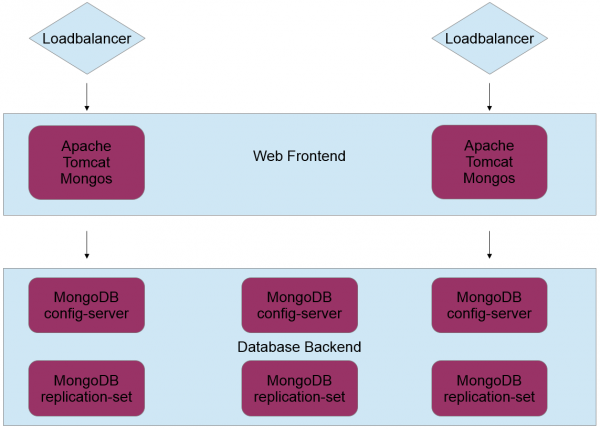Infrastructure
Contents
Servers
| Server | Software | Operating system | Resources |
|---|---|---|---|
| prod-ocid-web-01.colt.enaikoon.de | Apache + Tomcat + MongoS | Ubuntu 12.04 LTS | 2 vCPU, 4 GB |
| prod-ocid-web-02.colt.enaikoon.de | Apache + Tomcat + MongoS | Ubuntu 12.04 LTS | 2 vCPU, 4 GB |
| prod-ocid-cfgsrv-01.colt.enaikoon.de | MongoDB ConfigServer | Ubuntu 12.04 LTS | 1 vCPU, 2 GB |
| prod-ocid-web-02.colt.enaikoon.de | MongoDB ConfigServer | Ubuntu 12.04 LTS | 1 vCPU, 2 GB |
| prod-ocid-web-03.colt.enaikoon.de | MongoDB ConfigServer | Ubuntu 12.04 LTS | 1 vCPU, 2 GB |
| prod-ocid-db-01.colt.enaikoon.de | MongoDB Replication Set | Ubuntu 12.04 LTS | 4 vCPU, 48 GB |
| prod-ocid-db-02.colt.enaikoon.de | MongoDB Replication Set | Ubuntu 12.04 LTS | 4 vCPU, 48 GB |
| prod-ocid-db-03.colt.enaikoon.de | MongoDB Replication Set | Ubuntu 12.04 LTS | 4 vCPU, 48 GB |
Software stack
Operating System
All OpenCellID servers are running with Ubuntu Linux 12.04 LTS.
Frontend
The web frontend uses Apache web server as a proxy for serving web requests to Tomcat.
The OpenCellID web application is running on Tomcat and is reading and writing cell measurements data to/from the MongoDB database backend.
jQuery Mobile is responsible for provide cross-platform user interface. The map is displayed using OpenStreetMap combined with Leaflet library.
Database Backend
The database backend, with a current 4.4 million cell towers and about 565 million measurements (1.1.2014), is a MongoDB database cluster with six servers.
Three servers are serving as MongoDB configuration servers and the other three servers are serving as database backend with one replication set spread across the three servers.
Challenges and solutions
The OpenCellID community is very strong and continously provides a high number of measurements.
This immediately poses a few challenges:
- High Volume
data arrives from many differnet sources and is rapidly growing - Scale
growth of data should go along with predictable, incremental costs and no downtime should be needed when adding additional server resources - Data Processing
analyzing and processing of rapidly growing data must be constantly efficient.
The current solutions are based on MongoDB and its features:
- Native Analytics
using the integrated aggregation framework and Map/Reduce to calculate aggregates and analyses in place without the need of prior exporting data to other systems - Advanced Geo Queries
using geospatial MongoDB support to execute complex queries - Horizontal Scaling
sharding making it easy to scale applications horizontally on commodity hardware to accommodate growing increased throughput - Reduced Total Cost of Ownership
as open-source storage MongoDB is a very cost-effective solution
- Native Analytics
